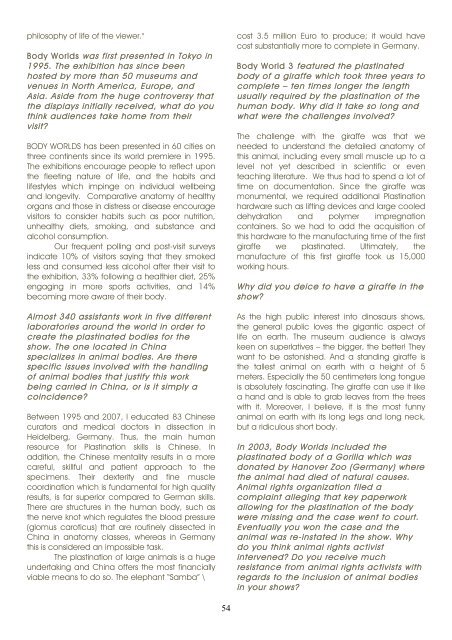Meet Animal Meat - Antennae The Journal of Nature in Visual Culture
Meet Animal Meat - Antennae The Journal of Nature in Visual Culture
Meet Animal Meat - Antennae The Journal of Nature in Visual Culture
You also want an ePaper? Increase the reach of your titles
YUMPU automatically turns print PDFs into web optimized ePapers that Google loves.
philosophy <strong>of</strong> life <strong>of</strong> the viewer."<br />
Body Worlds was first presented <strong>in</strong> Tokyo <strong>in</strong><br />
1995. <strong>The</strong> exhibition has s<strong>in</strong>ce been<br />
hosted by more than 50 museums and<br />
venues <strong>in</strong> North America, Europe, and<br />
Asia. Aside from the huge controversy that<br />
the displays <strong>in</strong>itially received, what do you<br />
th<strong>in</strong>k audiences take home from their<br />
visit?<br />
BODY WORLDS has been presented <strong>in</strong> 60 cities on<br />
three cont<strong>in</strong>ents s<strong>in</strong>ce its world premiere <strong>in</strong> 1995.<br />
<strong>The</strong> exhibitions encourage people to reflect upon<br />
the fleet<strong>in</strong>g nature <strong>of</strong> life, and the habits and<br />
lifestyles which imp<strong>in</strong>ge on <strong>in</strong>dividual wellbe<strong>in</strong>g<br />
and longevity. Comparative anatomy <strong>of</strong> healthy<br />
organs and those <strong>in</strong> distress or disease encourage<br />
visitors to consider habits such as poor nutrition,<br />
unhealthy diets, smok<strong>in</strong>g, and substance and<br />
alcohol consumption.<br />
Our frequent poll<strong>in</strong>g and post-visit surveys<br />
<strong>in</strong>dicate 10% <strong>of</strong> visitors say<strong>in</strong>g that they smoked<br />
less and consumed less alcohol after their visit to<br />
the exhibition, 33% follow<strong>in</strong>g a healthier diet, 25%<br />
engag<strong>in</strong>g <strong>in</strong> more sports activities, and 14%<br />
becom<strong>in</strong>g more aware <strong>of</strong> their body.<br />
Almost 340 assistants work <strong>in</strong> five different<br />
laboratories around the world <strong>in</strong> order to<br />
create the plast<strong>in</strong>ated bodies for the<br />
show. <strong>The</strong> one located <strong>in</strong> Ch<strong>in</strong>a<br />
specializes <strong>in</strong> animal bodies. Are there<br />
specific issues <strong>in</strong>volved with the handl<strong>in</strong>g<br />
<strong>of</strong> animal bodies that justify this work<br />
be<strong>in</strong>g carried <strong>in</strong> Ch<strong>in</strong>a, or is it simply a<br />
co<strong>in</strong>cidence?<br />
Between 1995 and 2007, I educated 83 Ch<strong>in</strong>ese<br />
curators and medical doctors <strong>in</strong> dissection <strong>in</strong><br />
Heidelberg, Germany. Thus, the ma<strong>in</strong> human<br />
resource for Plast<strong>in</strong>ation skills is Ch<strong>in</strong>ese. In<br />
addition, the Ch<strong>in</strong>ese mentality results <strong>in</strong> a more<br />
careful, skillful and patient approach to the<br />
specimens. <strong>The</strong>ir dexterity and f<strong>in</strong>e muscle<br />
coord<strong>in</strong>ation which is fundamental for high quality<br />
results, is far superior compared to German skills.<br />
<strong>The</strong>re are structures <strong>in</strong> the human body, such as<br />
the nerve knot which regulates the blood pressure<br />
(glomus caroticus) that are rout<strong>in</strong>ely dissected <strong>in</strong><br />
Ch<strong>in</strong>a <strong>in</strong> anatomy classes, whereas <strong>in</strong> Germany<br />
this is considered an impossible task.<br />
<strong>The</strong> plast<strong>in</strong>ation <strong>of</strong> large animals is a huge<br />
undertak<strong>in</strong>g and Ch<strong>in</strong>a <strong>of</strong>fers the most f<strong>in</strong>ancially<br />
viable means to do so. <strong>The</strong> elephant “Samba” \<br />
54<br />
cost 3.5 million Euro to produce; it would have<br />
cost substantially more to complete <strong>in</strong> Germany.<br />
Body World 3 featured the plast<strong>in</strong>ated<br />
body <strong>of</strong> a giraffe which took three years to<br />
complete – ten times longer the length<br />
usually required by the plast<strong>in</strong>ation <strong>of</strong> the<br />
human body. Why did it take so long and<br />
what were the challenges <strong>in</strong>volved?<br />
<strong>The</strong> challenge with the giraffe was that we<br />
needed to understand the detailed anatomy <strong>of</strong><br />
this animal, <strong>in</strong>clud<strong>in</strong>g every small muscle up to a<br />
level not yet described <strong>in</strong> scientific or even<br />
teach<strong>in</strong>g literature. We thus had to spend a lot <strong>of</strong><br />
time on documentation. S<strong>in</strong>ce the giraffe was<br />
monumental, we required additional Plast<strong>in</strong>ation<br />
hardware such as lift<strong>in</strong>g devices and large cooled<br />
dehydration and polymer impregnation<br />
conta<strong>in</strong>ers. So we had to add the acquisition <strong>of</strong><br />
this hardware to the manufactur<strong>in</strong>g time <strong>of</strong> the first<br />
giraffe we plast<strong>in</strong>ated. Ultimately, the<br />
manufacture <strong>of</strong> this first giraffe took us 15,000<br />
work<strong>in</strong>g hours.<br />
Why did you deice to have a giraffe <strong>in</strong> the<br />
show?<br />
As the high public <strong>in</strong>terest <strong>in</strong>to d<strong>in</strong>osaurs shows,<br />
the general public loves the gigantic aspect <strong>of</strong><br />
life on earth. <strong>The</strong> museum audience is always<br />
keen on superlatives – the bigger, the better! <strong>The</strong>y<br />
want to be astonished. And a stand<strong>in</strong>g giraffe is<br />
the tallest animal on earth with a height <strong>of</strong> 5<br />
meters. Especially the 50 centimeters long tongue<br />
is absolutely fasc<strong>in</strong>at<strong>in</strong>g. <strong>The</strong> giraffe can use it like<br />
a hand and is able to grab leaves from the trees<br />
with it. Moreover, I believe, it is the most funny<br />
animal on earth with its long legs and long neck,<br />
but a ridiculous short body.<br />
In 2003, Body Worlds <strong>in</strong>cluded the<br />
plast<strong>in</strong>ated body <strong>of</strong> a Gorilla which was<br />
donated by Hanover Zoo (Germany) where<br />
the animal had died <strong>of</strong> natural causes.<br />
<strong>Animal</strong> rights organization filed a<br />
compla<strong>in</strong>t alleg<strong>in</strong>g that key paperwork<br />
allow<strong>in</strong>g for the plast<strong>in</strong>ation <strong>of</strong> the body<br />
were miss<strong>in</strong>g and the case went to court.<br />
Eventually you won the case and the<br />
animal was re-<strong>in</strong>stated <strong>in</strong> the show. Why<br />
do you th<strong>in</strong>k animal rights activist<br />
<strong>in</strong>tervened? Do you receive much<br />
resistance from animal rights activists with<br />
regards to the <strong>in</strong>clusion <strong>of</strong> animal bodies<br />
<strong>in</strong> your shows?












